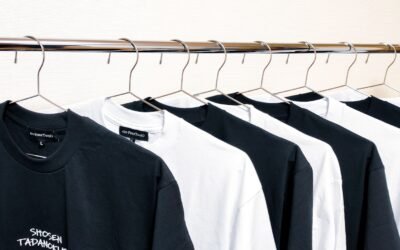When it comes to the fashion industry, most people don’t realize just how resource-intensive it can be, especially when it comes to water usage. T-shirts, a staple in nearly everyone’s wardrobe, might seem simple and straightforward. However, there’s a hidden truth about the amount of water it takes to produce these everyday garments. For those who are environmentally conscious, this can be an eye-opener.
Imagine your favorite t-shirt; you wouldn’t think it’s connected to rivers and lakes, yet the process behind making it involves a surprising amount of water. From growing the cotton to spinning, dyeing, and finishing, each step in the t-shirt production process consumes large volumes of water. By understanding these hidden depths, we can make more informed choices about the clothes we wear.
Water Usage in Traditional T-Shirt Production
The journey of a cotton t-shirt begins in a field, where water plays an essential role in growing cotton plants. Cotton farming requires a significant amount of irrigation to ensure healthy crops. This need can strain local water resources, particularly if the farming practices are not sustainable. Once the cotton is harvested, it moves into production, where the water demand continues.
1. Cotton Growth: Cotton plants need consistent watering, which might draw from rivers, reservoirs, or aquifers.
2. Fabric Dyeing: After the raw cotton is processed and spun into fabric, it’s time for dyeing. Dyeing is one of the most water-intensive stages in the production process. It involves immersing the fabric in large vats of water mixed with dyes, setting the desired color. This phase doesn’t just consume a lot of water; it often results in water pollution if waste isn’t handled properly.
3. Finishing Process: Once dyed, the fabric has to be washed and treated, further adding to the water consumption tally. These final touches ensure that the t-shirt feels soft, holds its color, and maintains its shape.
Understanding these steps highlights why it’s vital to look at how traditional t-shirt production impacts water resources. As we uncover the water needs in each stage, it becomes clear that opting for more sustainable practices can make a big difference.
Sustainable T-Shirts: The Water-Saving Alternative
With water resources being stretched thin, it’s reassuring to know there are better options in fashion. Sustainable t-shirts come into play as a great choice for reducing water use. These are not only kinder to the planet, but they also showcase innovative materials and methods that minimize water wastage.
These eco-friendly alternatives often use materials like organic cotton, bamboo, and hemp. Organic cotton, for example, is grown without synthetic pesticides or fertilizers, often utilizing rainwater more efficiently. Bamboo and hemp require significantly less water to grow, making them excellent choices for environmentally conscious clothing. Besides, these plants thrive with minimal irrigation, reducing stress on water sources.
Additionally, sustainable practices in textile manufacturing focus on optimizing water usage. Water-efficient farming technology and closed-loop dyeing processes ensure that each gallon counts, recycling water within the system rather than letting it go to waste. By opting for sustainable t-shirts, consumers can be part of a positive change, conserving water while still enjoying their favorite styles.
The Impact of Water Usage on the Environment
Water overuse in t-shirt production doesn’t just impact the immediate area of cultivation and manufacturing. Excessive water withdrawal leads to a drop in water levels, which can harm local flora and fauna. Rivers and aquifers suffer, and the ripple effects can destabilize entire ecosystems.
Besides, when large amounts of water are withdrawn for industrial processes, it can cause waterway pollution. This is particularly true in traditional dyeing processes, where contaminated wastewater can seep into rivers and lakes if not treated properly. The chemicals present in dyes and other treatments can poison aquatic life and disrupt natural habitats.
Conserving water becomes a crucial component of broader environmental goals like climate stability and biodiversity protection. Every drop saved counts towards a healthier planet. By understanding these impacts, we can support solutions that protect natural resources.
Tips for Choosing Water-Friendly T-Shirts
Picking the right gear makes all the difference in supporting water conservation. Here are some easy-to-follow tips to make sure your t-shirt choices are water-friendly:
1. Check Labels: Look for certifications like GOTS (Global Organic Textile Standard) or OEKO-TEX. They indicate responsible water use.
2. Opt for Eco-Friendly Fabrics: Choose materials like organic cotton, bamboo, or hemp, which use less water in cultivation.
3. Research Brands: Support brands committed to sustainable practices and transparency about their water usage.
4. Care Instructions: Wash clothes in cold water and air dry when possible, extending the lifespan of your t-shirts.
Embracing these practices not only helps reduce your water footprint but also promotes an ecological approach to fashion, encouraging others to follow suit. This effort goes a long way in supporting conservation efforts while enjoying stylish, sustainable options.
Join the Movement for a Greener Planet
Choosing sustainable options makes a real difference. By wearing water-friendly t-shirts, you contribute to global efforts in water conservation. You’re not just a consumer; you become a part of a movement that’s aware and conscientious about the planet’s limited resources.
Let’s remember that every choice matters. When you choose a sustainable t-shirt, you choose less water pollution and support for cleaner waterways. It’s about more than just the clothes; it’s about leaving a better world for future generations. With each conscious decision, you’re a step closer to a sustainable lifestyle, making our world a greener, better place.
Ready to take a step further in your environmental journey? Discover how choosing sustainable t-shirts not only helps the environment but also contributes to lasting water conservation efforts. Save Mother Earth invites you to embrace eco-friendly fashion and make every choice count toward a healthier planet.









